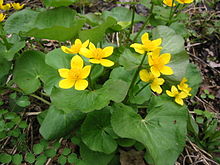Caltha
| Caltha | |
|---|---|
 |
|
| Caltha palustris ↑habit, ↓seeds | |
 |
|
| Scientific classification | |
| Kingdom: | Plantae |
| (unranked): | Angiosperms |
| (unranked): | Eudicots |
| Order: | Ranunculales |
| Family: | Ranunculaceae |
| Subfamily: | Caltheae |
| Genus: |
Caltha L. |
| Type species | |
|
Caltha palustris L. |
|
| Synonyms | |
|
Thacla Spach, Psychrophila DC |
|
Thacla Spach, Psychrophila DC
Caltha is a genus of rhizomatous perennial flowering plants in the family Ranunculaceae ("buttercup family"), to which ten species have been assigned. They occur in moist environments in temperate and cold regions of both the Northern and Southern Hemispheres. Their leaves are generally heart-shaped or kidney-shaped, or are characteristically diplophyllous (the auricles of the leaf blades form distinctly inflexed appendages). Flowers are star shaped and mostly yellow to white. True petals and nectaries are missing but the five or more sepals are distinctly colored. As usual in the buttercup family there is a circle of stamens around (two to twenty-five) free carpels.
Caltha species are hairless, dwarf to medium size (1–80 cm high) perennial herbs, with alternate leaves. These leaves are simple (in all Northern Hemisphere species), or have one pair of lobes at the base (in C. sagittata) which is mostly oriented at a straight angle to the larger top lobe but is sometimes in the same plain (in some of its northern populations), or the basal lobes are merged with the top lobe to form two (occasionally three) appendages (in all remaining species) which are attached next to the midvein, with the adaxial surfaces of top lobe and appendages facing each other. This condition of the Southern Hemisphere species is referred to as diplophylly. All species have stalked basal leaves, and some also have one or few leaves on the flowerstalk. The flowers are single on a short stalk in the middle of the rosette of basal leaves (Southern Hemisphere species) or in a mostly few-flowered corymb, without or with one or few mostly sessile leaflike stipules. Northern Hemisphere species have kidney to (elongated) hart-shaped leaves and stipules, with simple toothed or scalloped margins. Southern Hemisphere species between them show a variety in leafshapes. In C. appendiculata the top lobe is regularly more or less trifid, with an indent at the tip of each segment, but it is also often spoon-shaped with an entire margin with a more or less retuse tip. The top lobe in C. dionaeifolia is split into ovate left and right halves, which are distincly folded towards each other (plicate), and have a concave upper surface, an entire margin with toothlike hairs regularly spaced around its margins while the appendages are similar in shape but ½–⅔× as large. C. sagittata has wide arrowhead-shaped leaves with an entire margin and appendages triangular and about ⅔× as large, C. intriloba has narrow arrowhead-shaped to elongate ovate leaves with a slightly scalopped margin, with lanceolate-triangular appendages ⅔× as long. C. novae-zelandiae has spade-shaped leaves a bit longer than wide with a round and slightly retuse top and a slightly scalopped margin with appendages half as long, triangular with a blunt tip. Finally C. obtusa also has spade-shaped leaves, with a round and slightly retuse top, but these are about as wide as long and are distinctly scalloped particularly towards the base, and appendages about ¾× as long with a likewise scalloped outer margin and a straight entire inner margin. The actinomorphic flowers lack true petals and nectaries, but the five to nine (sometimes as little as four or as much as thirteen) sepals are distinctly colored yellow (rarely orange or red) to white (sometimes tinged pink or magenta). The shape of the sepals varies between broadly ovate, obtuse, oblong to lanceolate. The number of stamens range between 6–9 in the smallest species (C. dionaeifolia) and 60-120 in the largest (C. palustris) and likewise does the number of carpels range between 2-5 and 5-25. Stamens encircle the carpels and both are planted on a flat floral base. The pollen is yellow and tricolpate except in C. leptosepala ssp. howellii that has pollen with rounded apertures all over the surface (pantoporate) or an intermediate type (pantocolporate), and in C. palustris var. alba, that shows both pollen types. Each carpel contains several ovules set along the ventral suture. These mostly develop into sessile follicles, with elliptic to globular light brown to black seeds without wings, dependent on the species between ½–1½ mm. In C. scaposa follicles are stipitate and in C. leptosepala short stipitate to sessile. C. natans grows floating in fresh waters or on mud, but all other species are terrestrials that grow in moist soils.
...
Wikipedia
